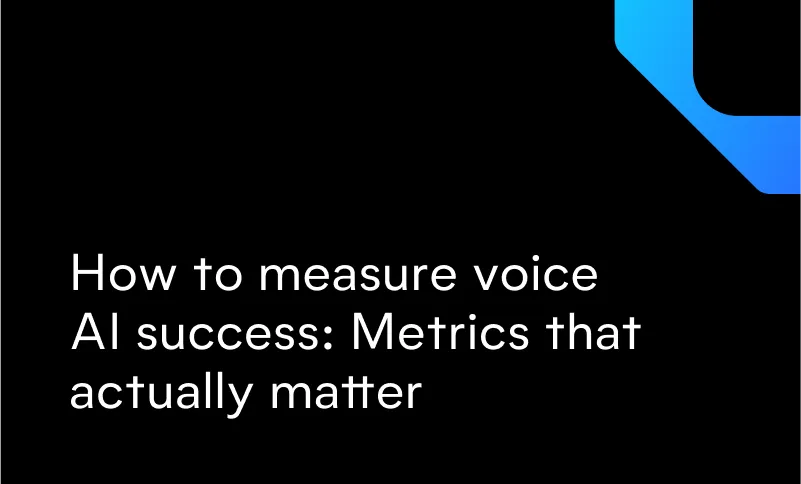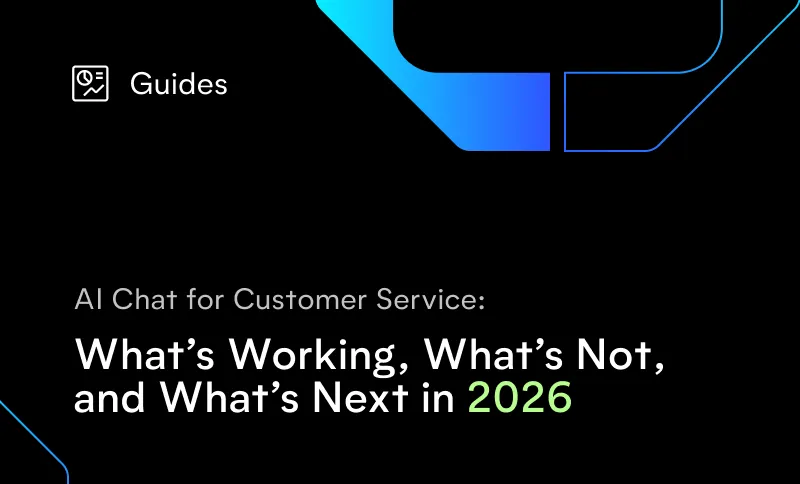
Voice AI has fundamentally changed contact center operations, but measuring its true impact requires looking beyond traditional metrics. While many leaders focus on basic call statistics, the most successful organizations track a more comprehensive set of indicators that reveal Voice AI's full business value.
Understanding which metrics truly matter can mean the difference between a Voice AI implementation that delivers clear ROI and one that leaves stakeholders questioning its value. This guide will help you identify, measure, and report the metrics that demonstrate real success with Voice AI in your contact center.
Moving beyond traditional contact center metrics
Typical contact center metrics like average handle time (AHT) and call volume provide only a partial picture when evaluating Voice AI performance. These traditional measurements were designed for human agent environments and fail to capture the unique capabilities and impact of AI systems.
Voice AI introduces new dimensions of performance that require specialized tracking. While reducing call volume might seem like an obvious goal, it doesn't tell you whether customer issues are actually being resolved or if satisfaction is improving. Similarly, handle time metrics don't account for the complex relationship between conversation length and resolution quality in AI interactions.
The three categories of Voice AI metrics that matter
Successfully measuring Voice AI requires tracking metrics across three distinct but interconnected categories:
1. AI-specific performance metrics
These metrics focus specifically on the technical performance of your Voice AI system:
- Resolution Rate: The percentage of calls where the Voice AI handles the entire interaction without transferring to a human agent. This core metric indicates how effectively your AI resolves issues independently.
- Intent Accuracy: How accurately your Voice AI identifies customer intents during conversations. Higher accuracy leads to more successful interactions and fewer frustrated customers.
- Transfer Rate: The percentage of calls transferred to human agents. This metric helps identify specific conversation types where your AI may need additional training or may be better suited to only resolve part of the interaction.
Monitoring these technical metrics provides visibility into your Voice AI's fundamental capabilities and highlights areas for improvement in the underlying technology.
2. Operational impact metrics
Beyond technical performance, Voice AI significantly impacts your contact center operations:
- Cost Per Resolution: The total cost of resolving a customer issue, including technology, staffing, and infrastructure expenses. This metric clearly demonstrates the economic impact of automation.
- First-Call Resolution Rate: The percentage of issues resolved during the initial customer contact. Voice AI can dramatically improve this metric by consistently following optimal resolution paths.
- Capacity Planning Efficiency: How accurately you can predict and staff for contact volumes. Voice AI typically makes forecasting more reliable by providing consistent handling times and coverage for seasonal call spikes.
These operational metrics connect AI performance to your contact center's efficiency and effectiveness, helping quantify the direct business impact of your Voice AI investment.
3. Business impact metrics
Ultimately, Voice AI must drive meaningful business outcomes:
- Customer Satisfaction (CSAT) and Net Promoter Score (NPS): These measurements reveal how customers perceive their AI interactions. Contrary to common concerns, well-implemented Voice AI often improves satisfaction scores by providing consistent, immediate service.
- Agent Attrition Rate: Employee turnover is a critical metric in contact centers. Voice AI typically reduces attrition by handling routine calls and allowing agents to focus on more engaging, complex issues.
- Return on Investment (ROI): The financial return generated by your Voice AI implementation, accounting for both cost savings, cost of the technology, and revenue impacts. This metric speaks directly to executive concerns about technology investments.
Business impact metrics demonstrate how Voice AI contributes to your organization's broader goals and helps justify continued investment in the technology.
Prioritizing metrics across implementation stages
Different metrics matter more at different stages of your Voice AI journey. Focusing on the right measurements at each phase helps set appropriate expectations and demonstrate progress.
First 30 days: Foundation metrics
During the initial deployment phase, focus on:
- Resolution Rate: Establish your baseline for AI-handled interactions
- Intent Accuracy: Ensure the system correctly understands customer requests
- Transfer Rate: Identify conversation types requiring human intervention
These metrics help you assess basic functionality and identify immediate optimization opportunities. During this period, technical performance is more important than business impact, as you're establishing the foundation for future success and scale.
Days 30-60: Operational impact
As your Voice AI stabilizes, shift focus to:
- Cost Per Resolution: Begin measuring the economic impact of automation
- First-Call Resolution Rate: Track improvement in one-contact issue resolution
- Agent Utilization: Monitor how agent time is being reallocated to complex issues
This phase connects technical performance to operational changes, demonstrating how Voice AI is transforming day-to-day contact center operations. You should see clear improvement in efficiency metrics during this period.
Days 60-90: Business value
By the third month, prioritize business outcome metrics:
- Customer Satisfaction: Compare CSAT for AI-handled vs. agent-handled interactions
- Agent Attrition Trends: Look for early indicators of improved retention
- Preliminary ROI Analysis: Calculate initial financial returns based on the first two months of data
This stage provides your first comprehensive view of Voice AI's business impact. These measurements create a compelling narrative for executives about the technology's value.
Creating an effective voice AI dashboard
Measuring the right metrics is only valuable if you can effectively communicate the results. A well-designed Voice AI dashboard should:
- Present a balanced view across all three metric categories
- Show trends over time rather than just point-in-time measurements
- Include comparison benchmarks against human agent performance
- Highlight both successes and areas for improvement
- Connect metrics visually to show relationships (e.g., how average handle time affects cost per resolution)
Consider organizing your dashboard into sections that tell a clear story about your Voice AI's performance, from technical capabilities to business outcomes. This structure makes it easier for stakeholders at all levels to understand the technology's impact.
Common voice AI measurement pitfalls to avoid
Many organizations undermine their Voice AI success by falling into common measurement traps:
Mistake #1: Focusing exclusively on containment rate
While important, containment rate alone doesn't indicate whether customers are satisfied or if issues are actually being resolved. A high containment rate could mask poor resolution quality if customers simply give up rather than request agent transfers, or if the call is finished with a low CSAT score. Instead, focus on resolution rate paired with CSAT score.
Mistake #2: Comparing Voice AI metrics directly to human agent metrics
Voice AI and human agents have fundamentally different strengths. Expecting identical performance across all metrics sets unrealistic expectations. Instead, focus on complementary capabilities that improve overall contact center performance. For example, Tier 2 calls that humans are taking might have a longer average handle times than the Tier 1 calls running through your AI agents. However, this is expected given that Tier 2 calls are inherently more nuanced and complex to resolve.
Mistake #3: Neglecting to measure long-term impact
Some of Voice AI's most significant benefits emerge over time, such as improved customer lifetime value and reduced agent training costs. Failing to track these long-term metrics undervalues the technology's true impact.
Reporting Voice AI success to executive stakeholders
Executives care about different metrics than operational leaders. When communicating Voice AI success to the C-suite:
- Focus primarily on business impact metrics (ROI, CSAT, agent retention)
- Connect operational improvements to strategic business goals
- Use comparative analysis showing before/after implementation impacts
- Include forward-looking projections based on current trend lines
- Highlight competitive advantages gained through Voice AI adoption
Tailor your reporting to address executive priorities like cost management, customer experience improvement, and workforce optimization. This approach helps secure continued support and investment for your Voice AI initiatives.
Building a culture of continuous improvement
Measuring Voice AI success isn't a one-time exercise but an ongoing process of refinement. The most successful implementations establish:
- Regular review cycles for all key metrics
- Clear ownership for performance improvement
- Processes to act on insights from conversation intelligence
- Testing protocols for new conversation flows and capabilities
- Feedback loops between Voice AI performance and future development
Organizations that treat metrics as tools for improvement rather than just performance reporting consistently achieve better long-term results from their Voice AI investments.
Conclusion
Measuring Voice AI success requires looking beyond traditional contact center metrics to encompass technical performance, operational impact, and business outcomes. By tracking the right metrics at each implementation stage and using conversation intelligence to uncover deeper insights, you can demonstrate clear value from your Voice AI investment.
The most valuable metrics tell a coherent story about how Voice AI is transforming your contact center operations and contributing to broader business goals. With a comprehensive measurement strategy, you can not only validate your current Voice AI implementation but also build the case for continued investment and expansion.
Ready to improve your Voice AI measurement strategy? Schedule a call to review your current AI reporting approach. Our experts can help you identify the metrics that matter most for your specific business goals and create a measurement framework that demonstrates clear value to all stakeholders.



.svg)


